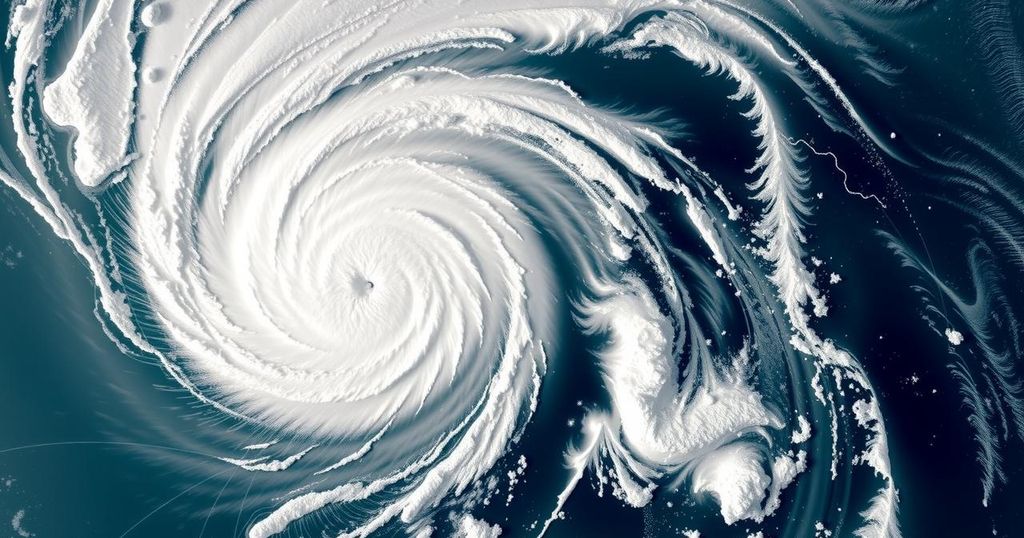Tropical Cyclone Dikeledi: Impact on Madagascar and Mayotte
Tropical Cyclone Dikeledi developed from a disturbance in the Indian Ocean, becoming a category 1 cyclone that struck northern Madagascar, resulting in three fatalities. The cyclone brought severe weather to Mayotte, leading to flooding and displacement of over 14,500 residents. Dikeledi is projected to reintensify and affect Mozambique, with wind speeds expected to exceed 100 mph later in the week.
Over the weekend, eastern Africa faced the significant threat of Tropical Cyclone Dikeledi, which originated as a minor tropical disturbance between Indonesia and Australia on January 2. This disturbance progressively transmuted into a depression, intensifying into a moderate tropical storm characterized by heavy rainfall and gusty winds exceeding 39 mph across central sections of the Indian Ocean. As the system advanced westward, it was officially designated as Dikeledi and eventually strengthened into a tropical cyclone on January 10, recording maximum sustained wind speeds of 74 mph, categorizing it as a category 1 hurricane in the Atlantic classification.
Dikeledi made its impact felt upon making landfall on Saturday in northern Madagascar, particularly between the cities of Vohemar and Antsiranana. The cyclone unleashed severe rainfall and strong winds, leading to the tragic loss of at least three lives. Following its landfall, Dikeledi weakened back into a tropical storm as it transitioned into the Mozambique Channel.
Continuing its path, the cyclone affected the French territory of Mayotte, resulting in significant rainfall that caused flooding and mudslides. This event followed closely behind the earlier devastation wrought by Cyclone Chido in December. Emergency shelters have been established, accommodating approximately 14,500 individuals who will remain there until the weather conditions improve, anticipated by late Monday.
Forecasts for Dikeledi indicate a continued southward trajectory down the Mozambique Channel, with model projections suggesting it may regain tropical cyclone status early this week. This resurgence is expected to bring heavy rain, thunderstorms, and strong winds to parts of Mozambique. Moreover, the cyclone is predicted to intensify into an intense tropical cyclone with average wind speeds surpassing 100 mph from Wednesday through Thursday, as it veers to the southeast, skirting the southern coast of Madagascar.
In tandem, the Adriatic Sea region experienced robust north-easterly wind gusts of approximately 45 mph, with peak gusts nearing 60 mph early Sunday morning. This event is attributed to the Bora, a katabatic wind phenomenon that typically manifests during winter months, which will likely diminish in intensity by Tuesday.
Tropical Cyclone Dikeledi serves as a significant reminder of the destructive potential of cyclonic weather patterns in the Indian Ocean region. Dikeledi’s origins can be traced back to a modest disturbance that formed between Indonesia and Australia, illustrating the evolution of weather systems in this area. The severity of impacts observed in Madagascar and Mayotte highlights the importance of preparedness and the continual threat posed by such natural disasters, particularly considering the recent encounter with Cyclone Chido just a month prior. Moreover, the Bora winds affecting Croatia evidenced the broader climatic influences of atmospheric phenomena, showcasing the interconnected nature of global weather patterns.
In summary, Tropical Cyclone Dikeledi has inflicted considerable hardship in Madagascar and Mayotte, resulting in tragic fatalities and displacement of vulnerable populations. As climate models show potential for Dikeledi’s reintensification, it is crucial for affected regions to remain vigilant and proactive in their disaster preparedness efforts. This situation underscores the ongoing challenges that tropical cyclones present while reaffirming the need for robust infrastructure and emergency response strategies to mitigate impacts from such natural calamities.
Original Source: www.theguardian.com




Post Comment